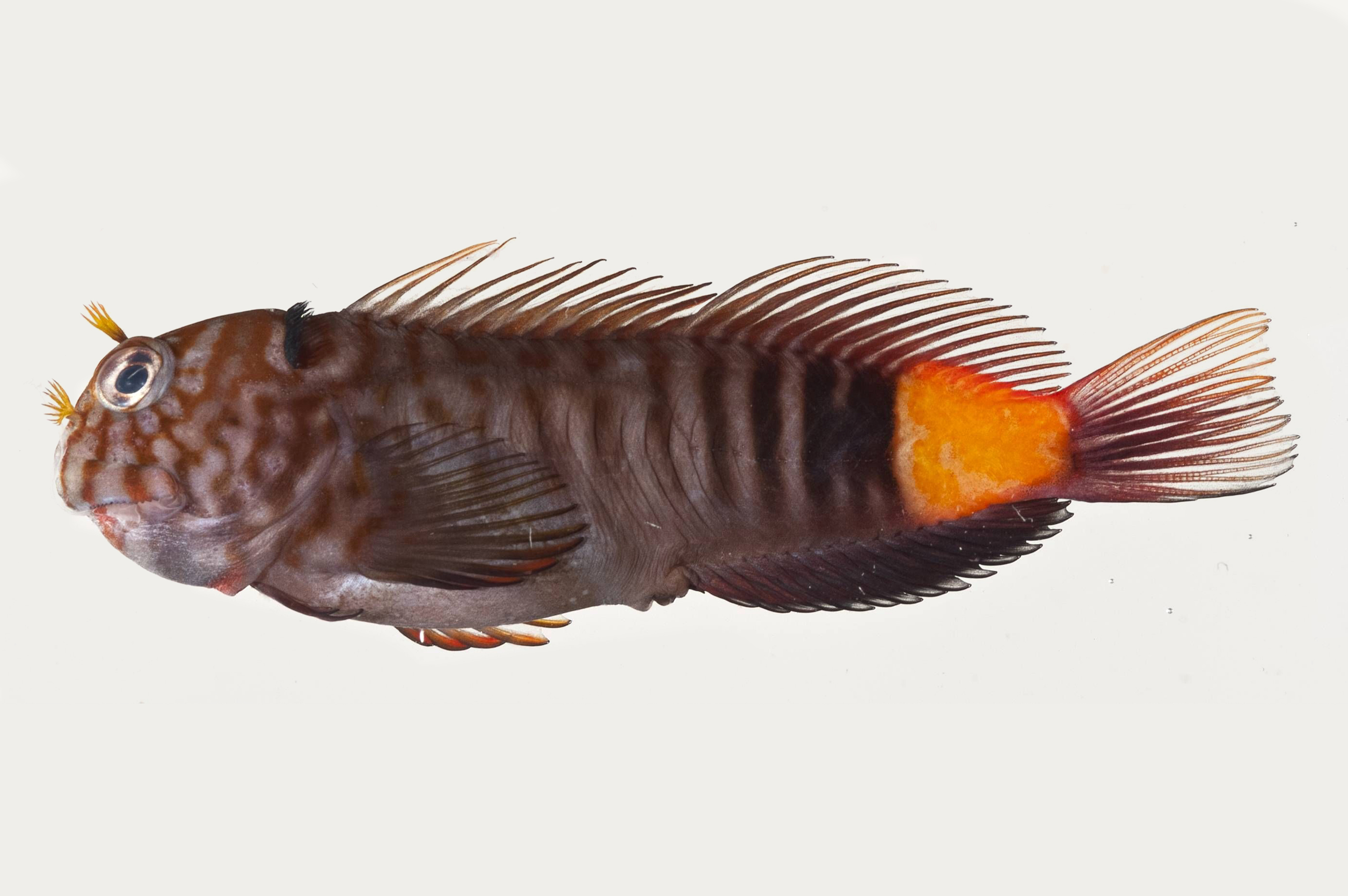Zebra Blenny, Cirripectes quagga (Fowler & Ball 1924)
Other Names: Squiggly Blenny

A Zebra Blenny, Cirripectes quagga, from the Marquesas Islands, French Polynesia, USNM 407979. Source: Jeffrey T. Williams, Division of Fishes, Smithsonian Institution, United States National Museum. License: CC by Attribution-NonCommercial-ShareAlike
Summary:
A small agile blenny ranging from uniform brown to individuals with bars, spots, or a yellow to scarlet red caudal peduncle, and an ocellated spot on the gill cover.
Cite this page as:
Bray, D.J. 2022, Cirripectes quagga in Fishes of Australia, accessed 27 Jun 2025, https://fishesofaustralia.net.au/Home/species/1902
Zebra Blenny, Cirripectes quagga (Fowler & Ball 1924)
More Info
|
Distribution |
Northern Great Barrier Reef to at least One Tree Island, Queensland; also Cocos (Keeling) Islands and Christmas Island in the eastern Indian Ocean. Elsewhere the species is widespread and locally abundant in the tropical, Indo-west-central Pacific. Inhabits the algal ridge and crests in the surge zone on exposed seaward reefs. |
|
Features |
Dorsal XI-XIII, 14-16; Anal fin II, 15-17; Pectoral fin 15; Pelvic fin I, 4; Caudal fin procurrent rays 10-15; Gill rakers 18-26; Vertebrae 10 + 21 = 30-32; Lateral line tubes 7-18. Head and body deep and greatly compressed; snout broad and obtuse, convex in profile; eye high and advanced; mouth broad and lower jaw inferior slightly. Dorsal fin membrane attached to caudal fin, with deep notch above last spine, first spine about equal to twice higher than second; lateral line without scales and scalelike flaps, canal ends below 7th dorsal-fin ray to caudal-fin base. Lower lip crenulated mesially, plicate laterally. Upper lip crenulae 32-46. Cephalic sensory pore system complex. Midsnout pores present. Cirri, supraorbital 2-15, nasal 6-16; nuchal 23-36, in 2 groups separated at midpoint of nape, no nuchal flap. Body depth at anal-fin origin 4.3 in SL. |
|
Feeding |
Herbivore - feeds on benthic algae. |
|
Etymology |
The specific name is from Equus quagga, the scientific name of the zebra, in reference to the “rather obscure cross lines or bands” on the body of this species. |
|
Species Citation |
Rupiscartes quagga Fowler & Ball 1924, Proc. Acad. Nat. Sci., Philad 76: 273. Type locality: Wake Island. |
|
Author |
Bray, D.J. 2022 |
|
Resources |
Zebra Blenny, Cirripectes quagga (Fowler & Ball 1924)
References
Allen, G.R. & Erdmann, M.V. 2012. Reef fishes of the East Indies. Perth : Tropical Reef Research 3 vols, 1260 pp.
Allen, G.R. & Smith-Vaniz, W.F. 1994. Fishes of Cocos (Keeling) Islands.Atoll Research Bulletin 412: 1-21.
Allen, G.R., Steene, R.C. & Orchard, M. 2007. Fishes of Christmas Island. Christmas Island : Christmas Island Natural History Association 2 edn, 284 pp.
Carlson, B.A. 1980. A new Indo-Pacific fish of the genus Cirripectes (Blenniidae, Salariini).Pacific Science 34(4): 407-414.
Delrieu-Trottin, E., Liggins, L., Trnski, T., Williams, J.T., et al. 2018. Evidence of cryptic species in the blenniid Cirripectes alboapicalis species complex, with zoogeographic implications for the South Pacific. ZooKeys 810: 127-138. https://doi.org/10.3897/zookeys.810.28887
Fowler, H.W. & Ball, S.C. 1924. Descriptions of new fishes obtained by the Tanager Expedition of 1923 in the Pacific Islands west of Hawaii. Proceedings of the Academy of Natural Sciences, Philadelphia 76: 269-274.
Hoban, M.L. & Williams, J.T. 2020. Cirripectes matatakaro, a new species of combtooth blenny from the Central Pacific, illuminates the origins of the Hawaiian fish fauna. PeerJ 8:e8852 https://doi.org/10.7717/peerj.8852
Hobbs, J-P.A., Newman, S.J., Mitsopoulos, G.E.A., Travers, M.J., Skepper, C.L., Gilligan, J.J., Allen, G.R., Choat, H.J. & Ayling, A.M. 2014. Checklist and new records of Christmas Island fishes: the influence of isolation, biogeography and habitat availability on species abundance and community composition. Raffles Bulletin of Zoology Supplement 30: 184–202 See ref online
Hobbs, J-P.A., Newman, S .J., Mitsopoulos, G.E.A., Travers, M.J., Skepper, C.L., Gilligan, J.J., Allen, G.R., Choat, H.J. & Ayling, A.M. 2014. Fishes of the Cocos (Keeling) Islands: new records, community composition and biogeographic significance. Raffles Bulletin of Zoology Supplement 30: 203–219 See ref online
Randall, J.E. 2005. Reef and shore fishes of the South Pacific. New Caledonia to Tahiti and the Pitcairn Islands. Honolulu : University of Hawaii Press 707 pp.
Randall, J.E., Allen, G.R. & Steene, R. 1990. Fishes of the Great Barrier Reef and Coral Sea. Bathurst : Crawford House Press 507 pp. figs.
Randall, J.E., Allen, G.R. & Steene, R. 1997. Fishes of the Great Barrier Reef and Coral Sea. Bathurst : Crawford House Press 557 pp. figs.
Springer, V.G. 2001. Blenniidae. pp. 3538-3546 in Carpenter, K.E. & Niem, T.H. (eds). The Living Marine Resources of the Western Central Pacific. FAO Species Identification Guide for Fisheries Purposes. Rome : FAO Vol. 6 pp. 3381-4218.
Williams JT. 1986. Phylogenetic relationships and taxonomic revision of the Blenniid Fish genera Cirripectes and Scartichthys. PhD thesis, University of Florida https://doi.org/10.5962/bhl.title.48741
Williams, J.T. 1988. Revision and phylogenetic relationships of the blenniid fish genus Cirripectes. Indo-Pacific Fishes 17: 1-78 figs 1-21 col. pls 1-7
Williams, J.T. 2014. Cirripectes quagga. The IUCN Red List of Threatened Species 2014: e.T48342428A48361110. http://dx.doi.org/10.2305/IUCN.UK.2014-3.RLTS.T48342428A48361110.en. Downloaded on 17 September 2016.




